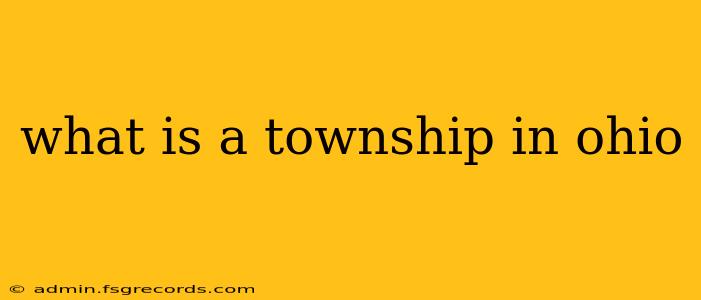Ohio's local government structure is a bit unique, and understanding its intricacies can be key to navigating property issues, local politics, and even finding specific services. One of the most often misunderstood aspects is the role of the township. This article will delve into what an Ohio township is, its functions, and how it differs from other local government units.
Defining an Ohio Township: More Than Just a Geographic Area
An Ohio township is a unit of local government, primarily responsible for providing essential services within its geographically defined boundaries. It's not just a name on a map; it's a functioning entity with elected officials, a budget, and specific responsibilities. Think of it as a foundational layer of local government, often existing alongside cities and villages.
Key Differences from Cities and Villages
While cities and villages are also units of local government in Ohio, they differ significantly from townships in several key aspects:
- Incorporation: Cities and villages are incorporated municipalities, meaning they've formally established themselves as separate legal entities with greater self-governance. Townships, on the other hand, are unincorporated. This means they are governed by state statutes and don't possess the same level of autonomy.
- Services Provided: Cities and villages typically provide a broader range of services, including police and fire protection, street maintenance, and water/sewer services. Townships often focus on more limited services, frequently including zoning, road maintenance (particularly in rural areas), and sometimes, park maintenance. The specific services offered vary widely depending on the township's size, resources, and the needs of its residents.
- Taxation: Both townships and incorporated municipalities levy taxes, but the types and amounts can differ substantially. Townships often rely more heavily on property taxes for funding.
The Role and Responsibilities of an Ohio Township Trustee
Each Ohio township is governed by a Board of Trustees, typically consisting of three elected officials. These trustees are responsible for:
- Road Maintenance: A significant portion of their responsibilities revolves around maintaining township roads, bridges, and ditches. This can range from simple pothole patching to larger-scale road construction projects.
- Zoning: Many townships have zoning regulations that dictate land use within their borders. The trustees oversee these regulations and their enforcement.
- Fire and Emergency Services: Some townships operate their own fire departments or provide funding for fire protection services. Emergency medical services may also be a township responsibility, depending on the local context.
- Parks and Recreation: Some townships maintain parks and recreational facilities, offering amenities like playgrounds and picnic areas for residents.
- Other Services: Depending on the specific township, other services might be offered, such as cemetery maintenance or assistance with public health initiatives.
Finding Your Township and Engaging with Local Government
Determining which township you reside in is crucial for interacting with local government. County auditor's offices and county GIS (Geographic Information System) websites are excellent resources for finding this information. Once you've identified your township, you can easily locate contact information for the Board of Trustees and learn more about specific services and local regulations.
Conclusion: Understanding the Importance of Ohio Townships
Ohio townships play a vital, albeit often understated, role in the state's local government structure. While their functions may be more limited than those of cities or villages, they provide crucial services to residents, especially in rural areas. Understanding the roles and responsibilities of your township is essential for informed participation in local governance and accessing essential services. By actively engaging with your township officials, you can help shape your community and ensure its continued success.

